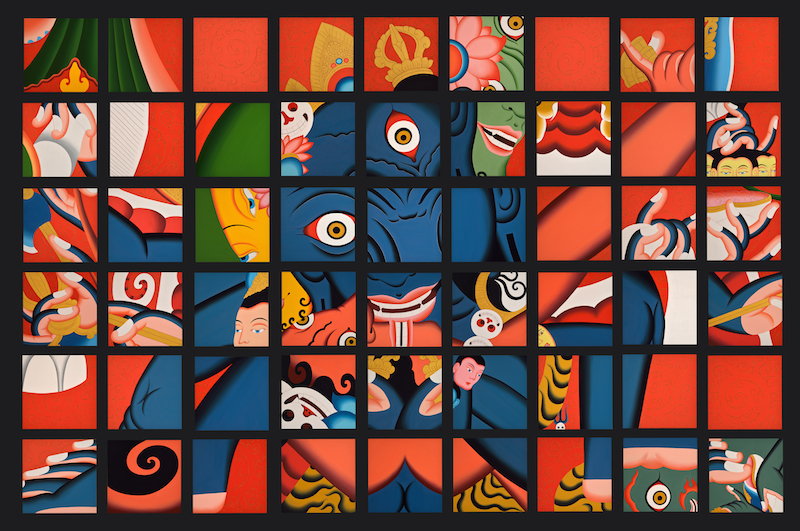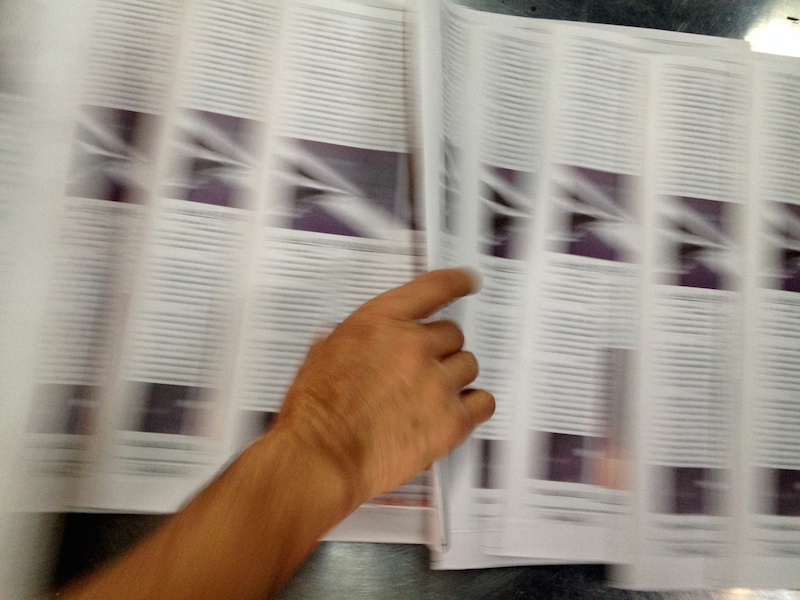
Naeem Mohaiemen, Shokol Choritro Kalponik, 2014. 8000 copies of newspaper distributed at the Dhaka Art Summit. Photo: Arifur R. Munir
The second Dhaka Art Summit opened a day after part of the Bangladeshi capital was unexpectedly shut down by strikes, but the three-day event presented a strong cross section of art from South Asia. Bearing with logistical difficulties, lack of infrastructure, and government restrictions, this forum for art from the region unveiled new notions of otherness that were no longer burdened by Western cultural conditioning. Works from fourteen solo projects and three curated shows from India, Pakistan, and Bangladesh created a lingua franca that was fresh in its use of historicity and cultural identity to transform and open new possibilities of looking and thinking.
Like most biennials in Asia that focus on geographical representation and underlying ethnographies, the Dhaka Art Summit showcased both internationally recognized artists and local art practices. What was apparent in all the works was a strong sense of pluralism that welcomes universal aspects. This phenomenon is best described in the words of the postcolonial theoretician Homi Bhabha, whose view that art from the subcontinent may be seen in a “nation space,” as opposed to a “nation state,” opens up the possibility of “creative intervention.”1
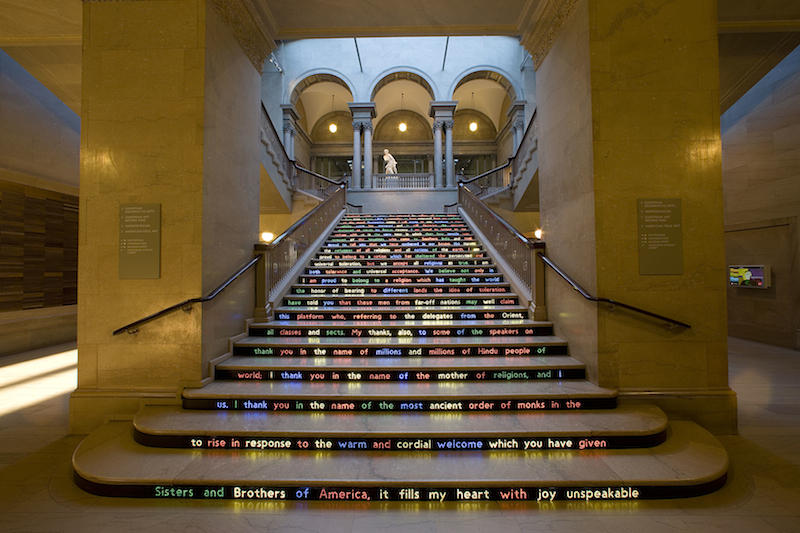
Jitish Kallat. Public Notice 3, 2010-2011. LED panels installed at the Art Institute of Chicago. Site-specific installation; dimensions variable. Courtesy the Art Institute of Chicago.
Jitish Kallat’s landmark exhibition Public Notice 3, at the Art Institute of Chicago (September 11, 2010–September 12, 2011), demonstrates Bhabha’s point. Installed on the risers of the museum’s grand staircase, 68,700 LEDs resurrected the text of a significant 1893 speech to end bigotry and fanaticism, delivered by Swami Vivekananda, an Indian monk in Chicago. Kallat’s meditation on religious tolerance commingled two important historical moments, highlighting the global significance of nation space and the role of art that can no longer be marginalized to the place of its historical antecedence.
Bhabha’s idea of nation space became a complex narrative of transformation in the Pakistan-born, New York–based artist Shahzia Sikander’s sound-video installation Parallax (2013), which was on view at the Dhaka Art Summit. Currently installed at the Bildmuseet in Sweden until May 18, 2014, Sikander’s unique combination of digitized miniature paintings, abstract forms, sound, text, and recitation of poetry in Arabic evoked thoughts of dissonance and disruption followed by rebirth and regeneration that assert the tenacious ability of humans to reinvent themselves. Viewers were compelled by new notions of otherness replete with cross-cultural historical references that resonate with audiences over the world.
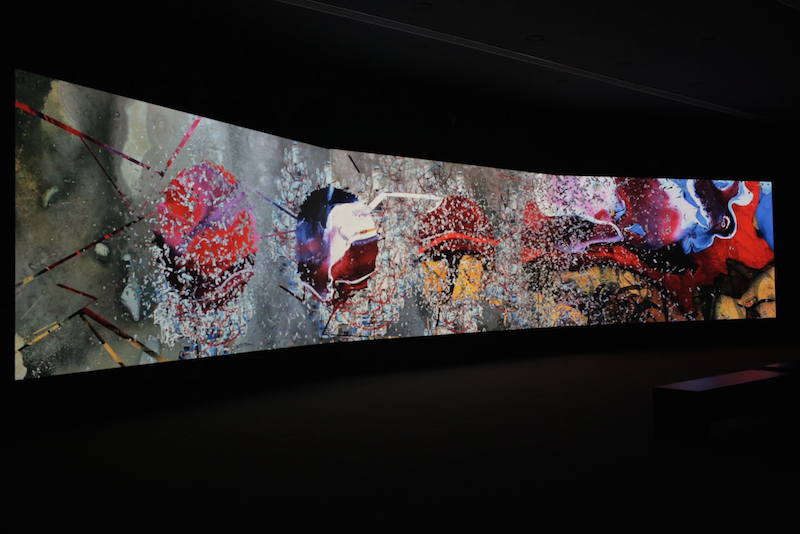
Shahzia Sikander. Parallax (detail), 2013. Three-channel HD animation with surround sound, installed at the Sharjah Biennial, 2013. Photo: Ian Forster/Art21. Courtesy the artist.
The Dhaka Art Summit set new standards for determining the quality of the selected works. Ever since the groundbreaking Whitney Biennial of 1993, the notion of aesthetic quality transcending ethnic boundaries has been frequently tested and redefined. In the work Wisdom and Compassion (2013), Tsherin Sherpa presented Buddhist deities that symbolize the union of truth and emptiness in a grid-like format. Sherpa’s nuanced canvas of disfigured gods in abstract shapes and bright colors altered traditional concepts of Tibetan artwork and opened viewers to new avenues for its assessment.
The subordinate voice was acknowledged through stacks of Naeem Mohaiemen’s subversive single-issue newspaper, Shokol Choritro Kalponik (2013). Reporting from the year 2024, the Bengali-language paper—whose title means “all characters are imaginary”—proffers an alternative, leftist point of view from the dystopia of daily life in Bangladesh. Using language that falls between research, whimsy, and humor, Mohaiemen addressed the notion of historical truth by pointing out that historical narratives vary with each individual. Viewers could take copies of the paper, which contained text that conveyed the importance of “othering,” in Homi Bhabha’s perspective, that gives significance to the excluded other and works towards leveling the inequities of communities.2
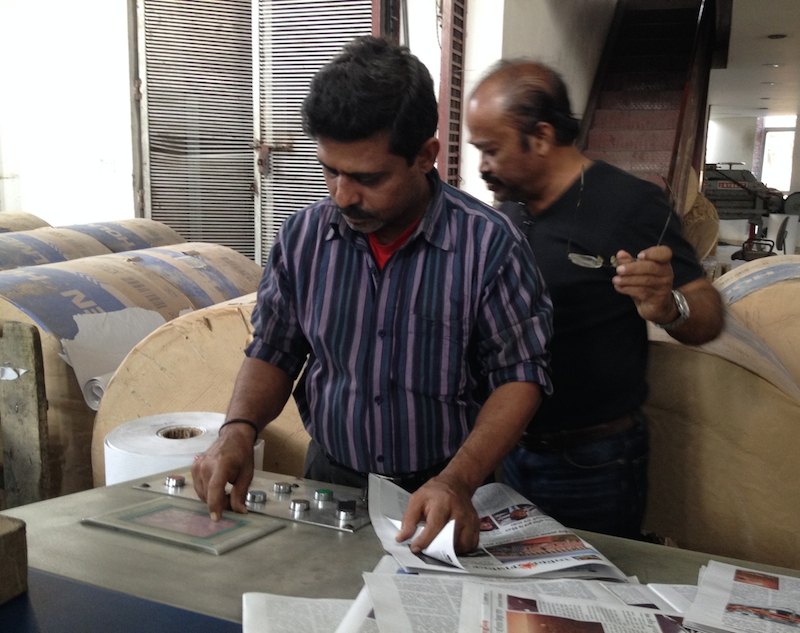
Naeem Mohaiemen, Shokol Choritro Kalponik, 2014. 8000 copies of newspaper distributed at the Dhaka Art Summit. Photo: Arifur R. Munir
Bringing different countries, genres, and mediums together, the biennial in Dhaka fortified its place as a forum for cultural exchange. Whether it was the Bangladeshi artists in Deepak Ananth’s exhibition, B/Desh, or the Pakistani artists in Ambreen Karamant’s Ex-ist, the Dhaka Art Summit, much like the Singapore Biennale and the Asia Pacific Triennial of Contemporary Art, established a close rapport among artists whose processes of recontextualizing tradition and modernity facilitated the mutability of artistic expression.
Ultimately the artists experienced a sense of rootedness without being insular and found a place where identity and otherness become one and the same. Freed from the burden of being marginalized and reinforced by each other’s visions, artists from South Asia found the Summit an important venue for strengthening their sense of belonging and endorsing art practices that continually reappraise the contemporary. It is no coincidence that, spurred by the strength of such expositions, the Indian contemporary artist Nilima Sheikh’s canvases are on view at the Art Institute of Chicago until May 2014, and the Indian modernist painter Vasudeo Gaitonde will be featured at the Guggenheim Museum, New York, later this year.
_________
1. Ghose, Madhuvanti, ed. Jitish Kallat: Public Notice 3. (Chicago: The Art Institute of Chicago, 2010), 78.
2. Ibid, 80.

